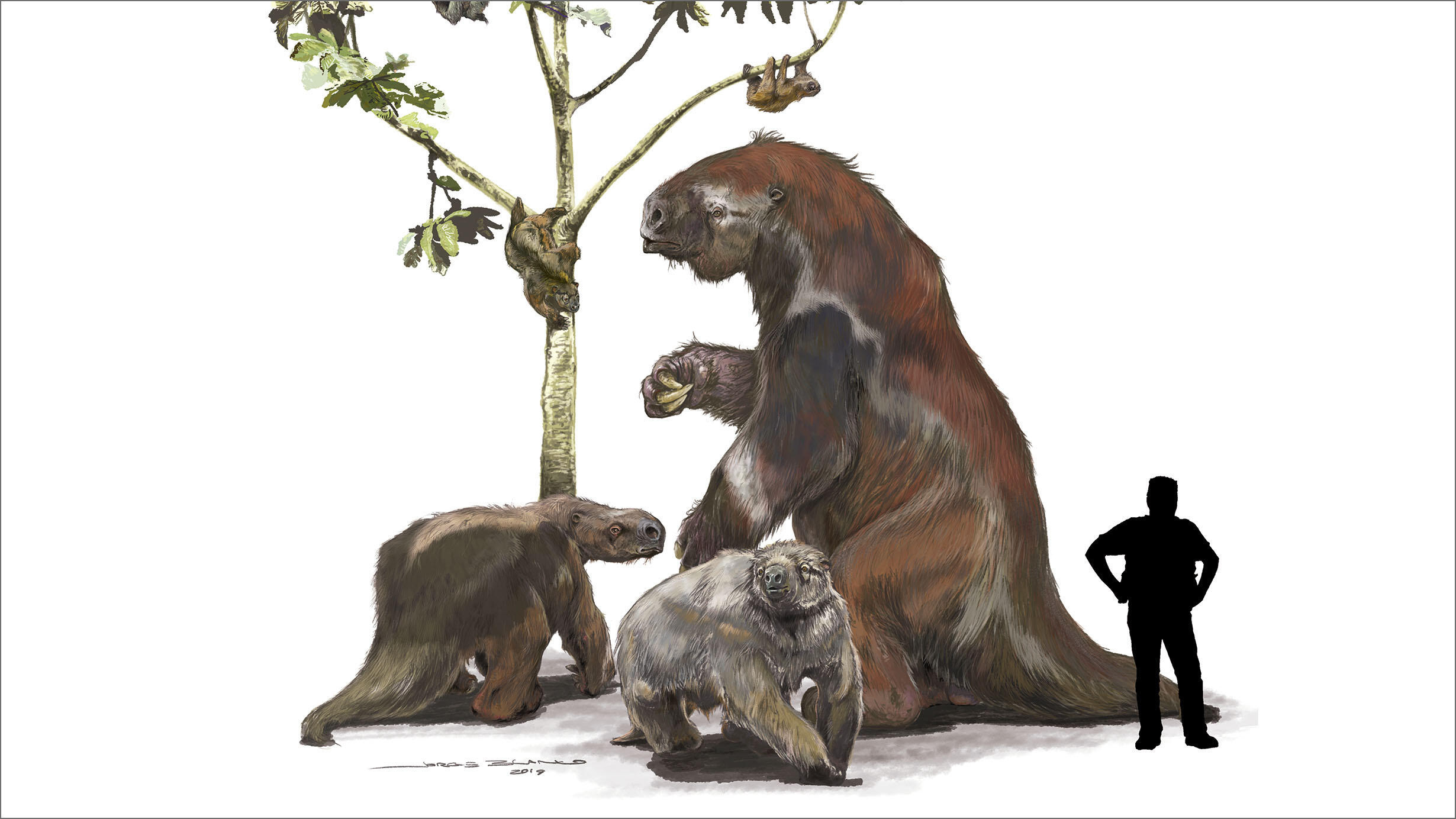 In the tree, clockwise from left: extinct West Indian sloth (Acratocnus), extant three-toed sloth or ai (Bradypus), and extant two-toed sloth or unau (Choloepus). Left to right on the ground: Mylodon (South America), Megalonyx (North America), and Megatherium (South America). Human for scale: 1.8.5 m (6 ft 1 in)
In the tree, clockwise from left: extinct West Indian sloth (Acratocnus), extant three-toed sloth or ai (Bradypus), and extant two-toed sloth or unau (Choloepus). Left to right on the ground: Mylodon (South America), Megalonyx (North America), and Megatherium (South America). Human for scale: 1.8.5 m (6 ft 1 in)© Jorge Blanco
With long arms, hook-like claws, and upside-down locomotion, the six species of living tree sloths may seem remarkably similar. Until now, anatomical features have shaped how scientists understand relationships among sloths. But new research based on biomolecules upends those longstanding ideas.
Two new molecular studies, conducted in parallel by researchers at French, Canadian, and American institutions (including the American Museum of Natural History), have analyzed the phylogenetic relationships of extinct and extant sloths. Although the scientists used two different sources of information—DNA and the protein collagen—they arrived at similar conclusions that challenge current views.
For example, the genus Bradypus (three-toed sloths) have long been regarded as being so anatomically different from other sloths that they were classified on a completely separate evolutionary branch. The new studies found this to be incorrect, noting that Bradypus fits deep within Megatherioidea, a group that also includes the extinct giant ground sloth Megatherium.
Similarly, the genus Choloepus (two-toed sloths) were found to be members of another major group called the mylodontoids. Previously they had been placed in Megalonychidae, a family originally defined to include the extinct North American ground sloth Megalonyx and a number of island species that lived in the West Indies until a few thousand years ago. Megalonyx, too, was found to be misplaced: according to the molecular evidence, it is clearly a megatheroid and might even be a close relative of the three-toed sloth.
D. Finnin/© AMNH
“All of us were initially surprised by our results because they thoroughly contradicted what seemed to be the accepted view based on anatomy,” said Frédéric Delsuc of the University of Montpellier, who was part of the team behind the study that appears in Current Biology. The team targeted the DNA housed in mitochondria, the cellular “energy engines” that exist in the body’s tissues and can be recovered from fossil material using ancient DNA capture methods.
The other team, whose paper appears in Nature Ecology and Evolution, conducted their research using paleoproteomics, which refers to the detailed analysis of protein (in this case, collagen) using mass spectrometry.
“Structural proteins like collagen potentially last much, much longer after death than the relatively fragile DNA molecule,” said Samantha Presslee, lead author of the Nature Ecology and Evolution paper and a doctoral student at the University of York. “This means that scientists can extract and interpret protein evidence from a wide range of extinct species well beyond the current reach of ancient DNA.”
Collagen can be found in large amounts in well-preserved fossils, allowing for the successful recovery of sequence information from fossils as old as 3.8 million years in some cases. In the case of the sloth study, the earliest fossil yielding good quality collagen was between 120,000 and 400,000 years old.
Each team also attempted molecular dating to interpret their evidence in the context of the sloth fossil record, as a way to predict when major groups separated from one another during the course of their evolution.
D. Finnin/© AMNH
This led to another major surprise: the combined molecular evidence suggests that the West Indian sloths, known as megalocnids, diverged from the ancestry of both megatherioids and mylodontoids more than 30 million years ago. The first sloths to reach the Greater Antilles may have entered over a temporary land connection between these islands and South America, called GAARlandia. At that point they split off from all other sloths, whereas they had previously been regarded as a minor, late-evolving group within the megatherioid radiation.
“Although the molecular results conflict with current taxonomic views based on anatomical features, there can be only one history of life,” said Ross D.E. MacPhee, the leader of the protein study and curator in the Museum’s Department of Mammalogy. “The job now is to reconcile these differing methods of inference, which means a lot more work on everyone’s part. We are going to learn a lot, and that’s exciting.”